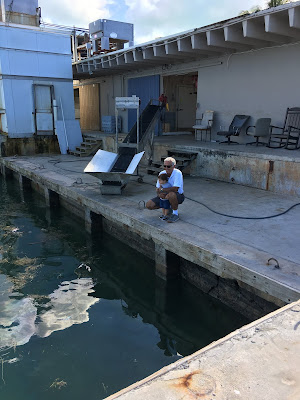On March 25, 1822, Lt. Commander Matthew C. Perry sailed into Key West and planted the U.S. flag, claiming the Keys as United States property. No protests were made over the American claim on Key West, so the Florida Keys became the property of the United States. It remained a part of the US except a brief period in 1982.
Key West lies at the southernmost end of U.S. Route 1, the longest north-south road in the United States (2,369 miles from Key West to Fort Kent, Maine). U.S. Route 1 is the only road into Monroe County. Key West is the county seat of Monroe County. It is 150 miles to the north end of the county (often a 4-hour + drive).
In 1982, the United States Border Patrol set up a roadblock and inspection point on US 1 just north of the merger of Monroe County Road 905A/Miami-Dade County Road 905A onto US 1, blocking the only road into Monroe County. This was during the Mariel Boat lift. Incoming and outgoing vehicles were stopped and searched for narcotics and illegal immigrants. Often the wait to get through the roadblock was 4 or more hours.
When the City Council's complaints went unanswered by the U.S. federal government and attempts to get an injunction against the roadblock failed in court, Mayor Wardlow and the Council declared Key West's independence on April 23, 1982. In the eyes of the Council, since the U.S. federal government had set up the equivalent of a border station as if they were a foreign nation, they might as well become one. Since many of the local citizens were referred to as Conchs, the nation took the name of the Conch Republic.
Prime Minister (formerly Mayor) Wardlow immediately declared war against the United States (symbolically breaking a loaf of stale Cuban bread over the head of a man dressed in a naval uniform). He surrendered after one minute of “war” and applied for one billion dollars in foreign aid (which still has not been received).
One of the books I read recently was Trapped in Key West by Peter M. Bacle (Pete). Peter tells his story of growing up in the world of commercial fishing. His father Peter C. Bacle founded the Stock Island Lobster Company over 60 years ago and it is still in operation. Pete tells the story of how his father got to Key West, fishing for lobster and stone crab, and cruising the Caribbean. He survived numerous confrontations with drug smugglers, adapted to the influx of refugees from Cuba (even helping in the Mariel Boat Lift), and relaxing with family and friends on secluded islands and beaches.
One of Jimmy Buffet’s very few direct references to Key West is by the original name Cayo Hueso in the song Everybody’s Got a Cousin in Miami
It was ninety miles to freedom but they took the risk
Though the ocean was all motion and the wind was brisk
The deadly gunboats never saw them in the pale moonlight
They were off to Cayo Hueso by the dawns early light
Remember that Even a Wasted Day is Better Wasted in Key West (Bo Fodor)
Lesson Learned: The bus system is not the best I have used, but I have taken a few trips north on the bus. Just be patient, the bus will be around later. Thankfully Key West is a very walkable city.
 |
| Riding the bus, you can see above the mangroves. |
 |
| The sounds of freedom from Boca Chica Naval Air Base |
 |
| U.S. Hwy 1 starts here |
 |
| Preparing to paint lobster trap floats at Stock Island Lobster Company |
 |
| The author of the book Trapped in Key West, Peter Bacle and his grandson. |
 |
| Lobster traps stacked up |
 |
| Wood to make lobster traps |
 |
 |
| The entrance to Stock Island Lobster Co. |
 |
| Sunset at Mallory Square |
 |
| Sunset at Mallory Square |
 |
| Louie's Back Yard - Made famous by JB's song Trying to Reason with the Hurricane Season Jimmy lived in the second floor apartment in the house next door to Louie's. |
 |
| The Dinghy Dock |

No comments:
Post a Comment